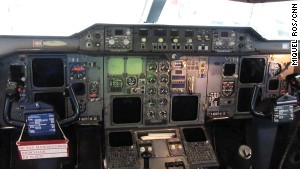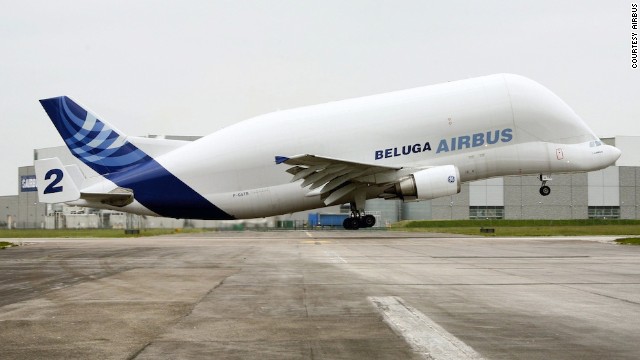Airbus' Beluga: Inside the world's strangest-looking airplane
January 17, 2014 -- Updated 0152 GMT (0952 HKT)
Popularly known as the "Beluga," because of its strong resemblance to the white Arctic whale, the Airbus
A300-600ST (ST stands for Super Transporter) is unique not only in
appearance, but also for the essential role it performs in European
aviation.
Airbus' production centers are scattered all over the continent, a legacy of its origins as a pan-European consortium.
Each factory specializes in the completion of a specific section of an aircraft.
The five Belugas, all
operated by Airbus, link these plants and take the different aircraft
sections to the final assembly line, either in Toulouse or Hamburg.
From guppies to belugas
Until the mid-1990s,
Airbus used another funny-looking aircraft to perform its big
transporting jobs -- the "Super Guppy," a derivative of the Boeing C-97,
a military cargo version of the 1940s Boeing 377 Stratocruiser.
The Super Guppy was already outdated by the time Airbus started using it.
Worse was the fact that
Airbus was relying on a couple of old aircraft from its chief rival,
Boeing, to handle the bulk of its logistics chain.
If it was to keep up with its frantic growth, Airbus concluded it needed something better.
The airframe chosen for
the job was taken from the Airbus A300-600, an aircraft that already had
a successful track record with airlines such as Lufthansa, Air France
and American Airlines.

The Beluga is operated by a crew of three: two pilots and a loadmaster.
.
Each of the five Belugas in operation are, actually, Airbus A300-600 jets that have been modified to carry large cargo.
The top section of the
aircraft was cut and an additional, wider fuselage section -- resembling
a bubble -- was added to the airframe, giving it its characteristic
hump.
The cockpit was lowered, making it possible for the cargo hold to be loaded and unloaded through the front of the aircraft.
The result is an incredibly spacious cargo hold.
Although the Beluga's
maximum payload of 47 tons is surpassed by a handful of other cargo
aircraft, its voluminous hold makes it suitable for transporting
oversized, but not particularly heavy, cargo. Like aircraft parts.
The Beluga can carry the wings of an A340 airliner or a fuselage section for Airbus' newest wide-body aircraft, the A350.
But it's not large enough to transport parts for the A380 super jumbo.
Those need to travel by boat, barge and road.
Belugas have occasionally been chartered to fly satellites, helicopters and even works of art.
Delacroix's "Liberty Leading the People" flew from Paris to Tokyo on a Beluga -- the canvas wouldn't fit into any other plane.

The Beluga transported this container holding a five-meter-high Egyptian statue from Berlin to Paris.
Coming up: Beluga XL
With the Beluga nearing two decades of indefatigable service, it's starting to show its age and limitations.
Since the Beluga's maiden flight in 1994, Airbus has multiplied aircraft deliveries by nearly five.
The company has become
more global, diversifying its supplier base and opening assembly plants
in China and Alabama -- well outside the Beluga's relatively short range
of 1,500 nautical miles with maximum payload.
In order to cope with the increasing workload, Airbus has put in place the so-called "Fly 10,000" program.
The program aims to
optimize the company's logistics infrastructure by increasing the work
performed by its transport fleet to 10,000 hours per year by 2017.
The plan includes the Beluga, which will be expected to fly many more hours per day.
With aircraft order
books at a historic maximum, however, Airbus can't afford to bet its
vital logistics operation chain on the readiness of five aging aircraft.
Though no decisions have been made, Airbus is looking at potential replacement solutions.
Tentatively called Beluga XL, the Beluga's replacement is likely to be based on the A330 airframe.
It's expected to have a
longer range and be able to carry a heavier payload, while still being
able to land at airports with relatively short runways, such as
Broughton, England, where Airbus makes wings for its airliners.
The next generation Beluga should also make it possible for Airbus to double its number of cargo flights to 120 per week.
What seems assured is
that the Beluga XL is going to look similar to the current version,
something plane spotters passing through Toulouse should appreciate.
Miquel Ros is an aviation blogger. An
economist by background, he's worked for Flightglobal and Bloomberg. He
currently covers the airline industry through Allplane.tv and other online media.


No comments:
Post a Comment